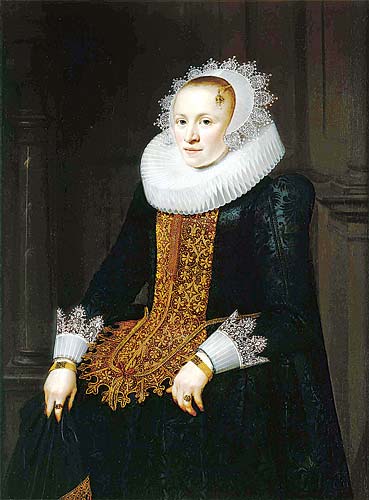
Portrait of a Lady, by Jan Anthonisz van Ravesteyn,
circa 1620-1625.
From Artinfo, March 9, 2008
“A good portrait,” wrote the poet Charles Baudelaire, ”always appears to me like a dramatized biography, or rather like the natural drama inherent in every man.” To take this point a bit further, a good portrait often reflects an artist’s complex interpretation of the sitter at a particular moment in time. Whether it is Jacques-Louis David’s heroic (if fictitious) image of Napoléon crossing the Alps in all his military and equestrian glory (he actually crossed on a mule) or one of David Hockney’s cool, dispassionate likenesses of his California friends and patrons, a portrait is literally an icon of its age. We respond to these pictures with a unique sense of personal identity and recognition that differs from our response to a landscape, a still life or nonrepresentational art.
“Portraits were out of fashion for a long while, but they seem to be back again,” says London dealer Johnny Van Haeften, who specializes in 17th-century Dutch and Flemish masters. “Perhaps it’s because portraits were once a slightly neglected part of the market, but now they represent a bargain.” Last year Van Haeften sold two pairs of portraits by Cornelius van der Voort and one pair (of a lady and a gentleman) by Jan Anthonisz van Ravesteyn, with each pair commanding $1 million to $1.5 million. “People are always interested in physiognomy,” he says, “and some of these portraits are very handsome indeed.”
The evocative power of the human face is paramount in portraiture. One can’t help but contemplate what a picture reveals about the subject’s personality – not to mention his or her relationship with the artist. Personal vanity was certainly a factor in the production of portraits, which also played a decisive role in the courtly dance of international diplomacy and matchmaking. Consider the earliest known full-length picture of Queen Elizabeth I, which appeared at Sotheby’s London in November after having resided in the same private collection since the 16th century. Painted by Steven van der Meulen and believed to have been commissioned expressly to help Elizabeth find a royal suitor, it shows the youthful Virgin Queen somewhat stiffly posed, her fine features and creamy complexion complemented by her richly patterned gown, with its rigid bodice emphasizing her slender torso and her elaborate jewelry suggesting the wealth and power at her command. The work’s visual appeal and the importance of its subject sparked vigorous competition at Sotheby’s among six bidders. It went to London dealer Philip Mould for £2,596,500 ($5.1 million), well beyond the £1 million ($2 million) high estimate.
Entire article here.

Leave a comment
Comments feed for this article